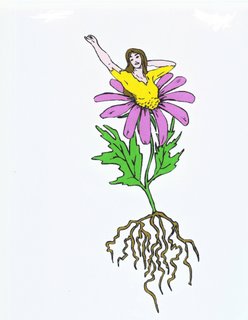Synergy in Aromatherapy
 Here's something I wrote a few years ago. Very slightly updated it now.
Here's something I wrote a few years ago. Very slightly updated it now.Synergy ~ The whole is more than the sum of the parts
The definition of synergy in relation to Aromatherapy appears elusive. The term synergy is usually used to describe a blend that offers the practitioner more than the simple addition of properties would permit. Some authors refer to the fragrance or the chemical properties but rarely apply both criteria to produce this mysterious super blend.Worwood (1990) suggests that ...
"mixing together two or more EOs[essential oils] you are creating a chemical compound that is different to any of the component parts." and that ...
" An increased potency can be achieved with synergistic blends without increasing the dosage." This appears to be the most commonly accepted description of syngergy. However, a good proportion of popular Aromatherapy books often give sample blends for various conditions E.G. ‘a relaxing synergistic blend’ . This is not truly in keeping with clinical Aromatherapy practice because, as therapists, we are trained to fit the oil and blend according to the person concerned. ‘One man’s meat being another’s poison’ so to speak.
Tisserand (1991) proposes that a minor constituent of the natural unadulterated EO may have a synergistic (controlling) effect. He quotes a translation from Dr Valnet's original text, Aromatherapie:"The natural , unadulterated essence has proved to be more active than its principal constituent....In 1904 Cuthbert Hall demonstrated that the antiseptic properties of Eucalyptus oil are much greater than those of its main constituent, eucalyptol."
He concludes that the vital life force is essential to provide this synergy. Hence EOs must be pure for any synergetic effect to result. ‘One molecule in an oil can make that difference.’ Price (1995) refers solely to the chemical mix on speaking of synergy and, like Tisserand, quotes the work of Dr Valnet. She concludes that the workings of synergy have yet to be fully determined. In relation to fragrance, a synergistic blend would contain perfume 'notes' of top, middle and bottom. A fulfilling blend indeed. However, if the client needed uplifting, the blend would likely compose middle and top notes. Similarly for a deeply relaxing blend, middle and base notes can be utilized. Whilst oils themselves can contain a range of notes, in order to call it synergistic, more than one oil needs to be blended.
Meanwhile, Maury (1990) advocates the use of IPs (individual prescriptions) and goes a stage further in implying that the resultant blend created from a (thorough) consultation matches the client 100%. It could thus be assumed that the blend and the client together create a healing synergy. A unique energy formed by the union of plants and humans in the search for balance of mind, body and spirit. (My comment: In the meantime we have ripped the plant from the soil, battered and boiled it to death. To compensate, we must thank nature and give something back for these spoils.)
To further this point, Ryman (1992) indicates that body odour alters when one is ill and cites examples such as 'scurvy smells of rotting meat.' Inferring from this that it is possible for an otherwise 'unnoticeable ' out of balance state to have its own particular odour too. Perhaps therapists unconsciously take notice of these aromas which assist an intuitive evaluation of the client’s needs.
Concerning instinctive oil selection, Lawless (1992) says : ' The precise make up of each oil not necessary for creating a good synergy; it is also a matter of getting to know the 'character' of each essential oil and trusting the intuition.'
Of course where there is synergy there can be adverse synergy. Caddy (1997) refers to the chemistry where two (or more) oils oppose each other. She calls this antagonism.
In conclusion, the term ‘synergy’ is currently applied to differing aspects of aromatherapy. I suggest that synergy only truly occurs when they are brought together. Namely these three conditions are met:
1. Only complete natural oils are used;
2. Knowledge of their respective chemical and therapeutic properties;
3. Understanding , knowledge and empathy between the therapist and the end user.
BIBLIOGRAPHY
Caddy,R (1997), Essential Oils In Colour p18, Amberwood, Surrey
Lawless, J (1992), The Encyclopedia of Essential Oils p31, Element, Dorset
Maury, M, (1990), Guide to Aromatherapy p98, C W Daniel, London
Price , S,(1995), Aromatherapy Workbook,Thorsons, London
Ryman , D, (1992), The Aromatherapy Handbook p37, C W Daniel, London
Tisserand , R, (1991), The Art of Aromatherapy,p68 , CW Daniel,Somerset
Worwood,V,A, (1990), Fragrant Pharmacy,p12, Bantam Books, London
FURTHER READING
Valnet,Dr, J, (1991), The practice of Aromatherapy, C W Daniel, London,
For those interested in the subject I suggest read all these books and more. For 'free' independent information on the net - try googling cropwatch or Martin Watt's aromatherapy pages.

1 Comments:
At 3:49 am, Anonymous said…
Anonymous said…
Hello Gill, I am studying aromatherapy as part of my remedial massage studies...I have really enjoyed reading your literature review...in fact the first scholarly review I have come across on the net. Do you know of any other sites that will afford me other scholarly reviews on aromatherapy?
Sandy
Post a Comment
<< Home